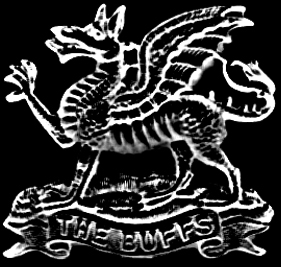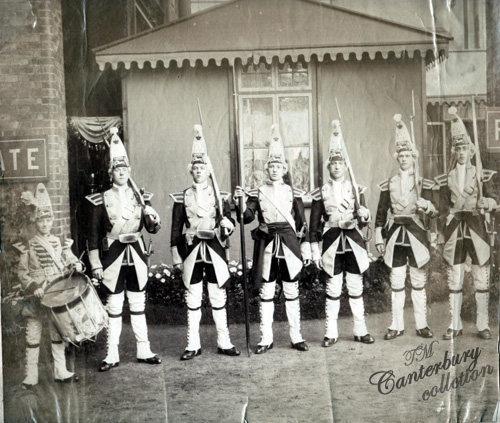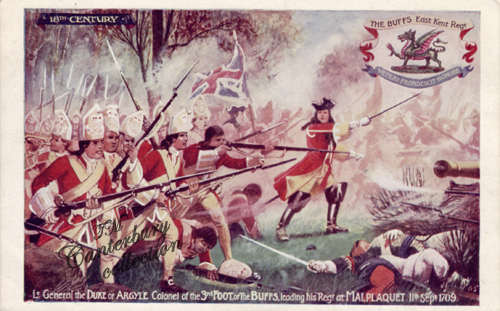
![]()
~ THE BUFFS ~
1701 - 1800
EAST KENT REGIMENT

The Buffs, an old photograph in my collection, uniform type c. 1751 (Grenadier)
1707
"In this year "Prince George of Denmark's Regiment" was permitted to display a dragon on its colours, as a regimental badge, as a reward for its gallant conduct on all occasions. The dragon, being one of the supporters to the royal arms in the time of Queen Elizabeth, also indicated the origin of the corps in her Majesty's reign. In this year was also St. Andrew's Cross added to St. George's Cross on the colours of the English regiments; and a colour with the two crosses was designated the Union."
1708
On the decease of H.R.H. Prince George of Denmark, Oct. 28, 1708, the regiment was no longer distinguished by his title. "In official returns and orders it was distinguished by the name of its colonel: in newspapers and other periodical publications it was sometimes styled the Holland Regiment; and it eventually obtained a title from the colour of the clothing. The men's coats were lined and faced with buff; they also wore buff waistcoats, buff breaches and buff stockings, and were emphatically called "The Buffs." May it not also partly have arisen from the Yorkshire word "To stand buff"? ie."firm"
Lt. General the Duke of Argyle, Colonel of the 3rd Foot of the Buffs, leading his Regiment at MALPLAQUET 11th Sept. 1709. A postcard from my collection c. 1906.
~ NEW ~
1744
"The Secretary at War, sent Orders to the several Regiments of Horse and Foot in Kent, to ease the Inns by quartering no more than six at a House."
"Orders were sent to Flanders for the Return of 6000 British Troops, on the first Notice of a French Invasion." GM Mar 1744
*two additional companies were raised in 1745 (were disbanded in 1749)
1745 they were in Brussels, returned to England via Northumberland in Nov.
1746 the Buffs were in Scotland, Edinburgh then Carlisle
1747 the Buffs were in the Island of Voorn, Holland, returned to England and stationed at Canterbury, Faversham, Deal and Sandwich
1748/9 remained in Kent
1750 "from this time the regiment appears to have passed a period of 10 years on home service, without being engaged in any transaction of importance."
1751
On July 1, 1751, a royal warrant was issued respecting the clothing and colours of every regiment. In this warrant the regiment is designated the 3rd or Buffs, and it is authorized to bear in the centre of its colours -
"The dragon, being the ancient badge, and the rose and crown in the three corners of the second colour. On the grenadier caps the dragon; white horse and king's motto on the flags. The same badge of the dragon to be painted on the drums and bells of arms, with the rank of the regiment underneath."
Note of declaration of War on France 22 May, 1756
1756
"In this year it was increased to twenty companies, and divided into two battalions."
1756 the regiment was augmented and increased to twenty companies, and the regiment was divided into two battalions.
Notes on Hessian and Hanoverian regiments in Canterbury, May, 1756; attendance by them on Ascension Day at Sermon House and French Church. CCA
1757 Isle of Wight, expedition against the coast of France, returned to England
*1756...March 2, upon a motion made by Mr. Secretary Fox, it was ordered, that a committee should be appointed to consider of the hardships of innholders, and other publick-house keepers, in the counties of Essex, Kent, and Surry, and in the city of Canterbury, from the late quartering of extraordinary numbers of officers and soldiers upon them, which the then exigency had rendered unavoidable; and that they should report the same to the house, with their opinion, as to what might be proper for the speedy relief of such innholders and public-house keepers. And a committee being accordingly appointed, petitions were presented on the 18th from several places in the counties of Hertford and Sussex who had suffered in the same way, and praying relief; which petitions, with another of the same kind from Staines, in Middlesex, afterwards presented, were referred to the said committee. On the 29th the resolutions of the said committee being reported by Mr. Rigby, they were all agreed to, and were as follows: First, that there had been a very extraordinary number of troops quartered in the counties of Essex, Kent, and Surrey, and in the city of Canterbury, and in some towns in the counties of Hertford and Sussex, since Michaelmas then last. Secondly, that in consequence of the additional charge brought upon the innholders and other public-house keepers, in the respective places, where the burthen had been most grevious, many of them had been obliged to shut up their houses merely upon that account, and many more were likely to be obliged to undergo the same fate. Thirdly, that the sufferings of such innholders and other publick house keepers, was case of compassion worthy the consideration of the house, especially as the grievance had arisen from a wise and proper disposition of his majesty's forces in that critcial conjuncture. Fourthy, that an humble address should be presented to his majesty, that he would be graciously pleased to order such allowance, as his majesty should judge reasonalbe, to be made to the innholders and other publick-house keepers, in the several counties of Essex, Kent and Surry, and in the city of Canterbury, and in the several towns of Hertford, Ware, and Hoddesdon, in the couty of Hertford, and Lewes, Cliff, Southover and East-Grinstead in the county of Sussex, in consideration of hte great expences they had been put to by the very extraordinary number of officers and soldiers, which had been necessarily quarted upon them during the last winter, especially as the grievance had arisen from a wise and prudent disposition of his majesty's forces in that critical conjucture; and to assure his majesty, that that house would make good such expence as should be incurred by his majesty upon that account.
Motions in the house of Commons
1757 - Canterbury May 25.. We hear there will be a Camp formed on Barham Downs near the Windmill, under the Command of the Duke of Marlborough. The London Chronicle. Vol 1
1757...We hear that there will be a Camp in the Old Park near this city.
1758 French West India Islands, Island of Guadeloupe
1758
In this year the second battalion was constituted the 61st Regiment.
1760 Returned to England to recruit
1761 BelleIsle, a French island off the Bay of Biscay off the coast of Brittany
1762/3 Portugal
1763-71 Island of Minorca
1771-74 Stationed in various parts of the southern and western counties
1775 Proceeded to Ireland where it remained for nearly 7 years/6
1780
March - The Kentish Gazette
East-Kent Regiment of Militia,
Commanded by
Colonel John SAWBRIDGE, Esq.
Wanted
Several Substitutes to serve for there years in the above regiment. Any young single man, five feet six inches high, who is able and willing to serve in that Station, by applying to Serjeant Major Richard ROUSE, or John POWELL at the BUTCHER'S ARMS, in Butchery Lane Canterbury, shall receive every encouragement that can be given.
1781 the regiment embarked from Ireland in March 1781, arrived in Charleston, South Carolina (USA)
1782
In August 1782, His Majesty's commands were conveyed to the Buffs, directing them to assume the title of East Kent Regiment, and in order to facilitate the procuring of recruits, to cultivate a connexion with that division of the county. This order was communicated to the regiment in a letter from Field Marshal Conway, commander in chief of which the following is a copy:
"London, 31st August, 1782
Sir,
His Majesty having been pleased to order that the regiment of foot which you command shall take the county name of Third or East Kent Regiment, and be looked upon as attached to that division of the county, I am to acquaint you it is His Majesty's further pleasure, that you shall in all things conform to that idea, and endeavor, by all means in your power, to cultivate and improve that connexion so as to create a mutual attachment between the county and the regiment, which may at all times be useful towards recruiting the regiment; but as the completing of the several regiments, now generally so deficient, is, in the present crisis, of the most important national concern, you will, on this occasion, use the utmost possible exertion for that purpose, by prescribing the greatest diligence to your officers and recruiting parties, and by every suitable attention to the gentlemen and considerable inhabitants; and as nothing can so much tend to concilitate their affections as an orderly and polite behaviour towards them, and an observance of the strictest discipline in all your quarters, you will give the most positive orders on that head; and you will immediately make such a disposition of your recruiting parties as may best answer that end.
I have the honour to be, &c.,
H.S. Conway"
1782. In this year it was styled the 3rd East Kent Regiment, or the Buffs, by the commands of his Majesty by a letter dated London, August 31, 1782, from Field Marshal Conway, Commander-in-Chief.
1782-1790
The regiment remained in Jamaica from 1782 until the spring of 1790, when, having been relieved by a battalion of the Royal regiment, it embarked for Europe, arrived in England on the 24th of April, and was stationed at Portsmouth.
Historical Records of the British Army
1786
The decease of Lieut.-General William Style having occurred in March, 1786, King George III. conferred the coloneley of the Buffs, or East Kent regiment, on Lieut.-General Thomas Hall, by commission dated the 18th of April, 1786.
The regiment remained in Jamaica from 1782 until the spring of 1790, when, having been relieved by a battalion of the Royal regiment, it embarked for Europe, arrived in England on the 24th of April, and was stationed at Portsmouth.
Historical Records of the British Army
1794
"From this station the BUFFS were called, in the summer of 1794, to proceed to the Netherlands, to join the Anglo-Hanoverian army commanded by His Royal Highness the Duke of York, who, in consequence of the French having, by their superior numbers, gained considerable advantage over the Austrians, had been forced to retire from Flanders to Holland. The regiment landed at Bergen-op-Zoom, joined the army commanded by the Duke of York, at the camp at Rosendael, in the beginning of August and retreated from thence in a few days afterwards to the plains of Breda. The BUFFS were brigaded with the fortieth, fifty-fifth, fifty-ninth and eight-ninth regiments, under the orders of Major General Stewart; and after remaining about six weeks without camp-equipage, were furnished with those necessary articles, the want of which had subjected the regiment to serious inconvenience.
In September the army again retreated and took up a position near Nimeguen. Lieut.-Colonel Lord Newark, of the BUFFS, having retired from the service, he was succeeded by Lord Craven, "a gallant young nobleman in his twenty-fourth year," whose appointment was dated 25th September, 1794."
Historical Records of the British Army 1837
The number of private men to be raised in each county...
Kent and Canterbury - 960
The statutes at large from the Magna Charta 1794
John ROUSE, gent. to be ensign. Samuel Elias SAWBRIDGE and John DEEDES, esqrs, to be captains. Thomas Papillon, esq. to be major. Jonson MACAREE, esq. to be captian-lieutenant. John ROUSE, gent. to be lieutenant, in the East Kent Militia.
James SIMMONS, John HODGES, and Richard STAINES, esqrs. to be captains - John Hollingbery STRINGER, John JONES, Thomas HAMMOND, Thomas STAR, Richard MOUNT, and John MATHEWS, gents. to be lieutenants, in the Canterbury Volunteer Companies. KR1794
1795
The Canterbury Barracks were finished, and on the 1st of October, the New Romney Light Dragoons, commanded by Colonel C. DERING, marched in as the first occupiers. They were began on the 6th May, 1794, and enclosed sixteen acres.
1796
"After the reduction of St. Lucia, reinforcements arrived at Grenada, to complete the conquest of the island; when the force under Brigadier-General Campbell crossed the country in the direction of Morne Quaco, and the BUFFS were placed under Brigadier General Count Hollimes, with his rifle corps, (afterwards the fifth battalion of the sixtieth regiment). Count Hollimes attacked the brigands in front, and the post was carried in the course of a few hours, with comparatively little loss. This terminated the contest, the insurgents no longer appeared in hostility, and the whole island was reduced to obedience in October."
Historical Records of the British Army 1837
1796 - Major Edwards and Lieutenant Williams of the Buffs were killed, and Lieutenants Campbell and Harding were wounded close to the entrenchment.
1799
July 15th, Orders from H.R.H. the Commander in Chief. Horse Guards.
"The troops now encamped near Southampton are immediately to move to the neighbourhood of Canterbury. They consist of two brigades of Guards and two brigades of the Line, with one squadron of the Eighteenth Light Dragoons. The Light Dragoons will have a separate route on the left of the whole, and be quartered on their march; they will be directed to Canterbury Barracks.
August 5th. Extract from General Sir C. GREY's Orders. Head Quarters, Barham Court
"G.O. The Commanding Officer of the Eighteenth Light Dragoons will, in like manner, send and emarkation return as soon as he receives orders to march from Canterbury."
Canterbury, Ramsgate, &c. on the sea coast, have lately been the scene of extraordinary confusion and bustle, from the assemblage and embarkation of the army destined for the expedition against Holland. - The Monthly Magazine Sept 1800
Motto "Veteri Frondescit Honore"....."With its Ancient Honour it is Evergreen"
© T. Machado 2007

